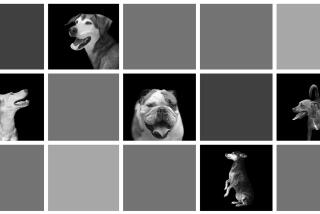Advertisers Cash in on Animal Magnetism
- Share via
NEW YORK — Judging by their population on the Super Bowl and everyday TV, it seems advertising’s going to the dogs . . . not to mention cats, cows, alligators, penguins, elephants, rhinos, bears and other creatures.
Indeed, ad land has become something of a Noah’s Ark. PepsiCo’s Village Bears danced, and its cows raided store shelves. Leather jacketed dive-bombing pigeons bent on dropping a little present, paint Nissan Motor Corp. USA’s cars as tough to catch. And a dog exerting “mind over master,” gets to take a Nissan Pathfinder on a late-night joy ride.
Showing commuters on donkeys suggests an alternate way to reduce car insurance other than calling Geico. A herd of rhinos demonstrates how Mercedes-Benz is the car for the “jungle out there.” One rams the car, which is protected by a side air bag.
“They created an unexpected environment from which a key marketing point could be addressed,” said Michael Drazin, a spokesman at Interpublic Group’s SMS/Lowe & Partners, the Mercedes agency.
A turtle in a squeaky cage highlights BMW’s speed, Merrill Lynch & Co. remains bullish on the bull and Dreyfus Corp.’s lion still roars this winter. Rolo’s elephant can’t forget the candy’s intoxicating taste--and 20 years later swats the boy who once deprived him of it. Chimps from Africa’s Gombe wildlife preserve ape what they see on HBO.
Warner-Lambert Co.’s alligator warns what skin can turn into without Lubriderm cream. A dog accused of spilling the garbage employs a Polaroid Corp. camera to finger the real culprit: the cat. And Ethan Allen Interiors Inc. is whole hog for Ursula, a 350-pound Kodiak bear.
“Presumably, a bear that hibernates for four months would look for the most comfortable place to do it,” Vice President Lenora Kirkley said.
*
Coca-Cola Co. may have led the pack with a couple of animated polar bears and swimming elephants. But the popularity of Anheuser-Busch Co.’s frogs, ants, Clydesdales, penguins and now turtles has opened the barn doors. In a new spot, Gus stops his delivery truck to usher a reptile to safety only to have his truck beamed up by a UFO.
“There’s nothing new you can say about Budweiser,” said David Vadehra, president of New York research company, Video Storyboard Tests. “All you need do is get my attention. Animals do that even better than children and differentiate their products from the pack.”
Budweiser’s has been the most popular campaign in the U.S. for the past two years, said Vadehra, adding that the success of the movie “Babe” also might have intensified the rush to the stable.
“Animals, children and young women, in that order, seem to intrigue people,” said Rick Dublin, head of the Minneapolis production company that bears his name. Animals are “fun to watch and because of their innocence, viewers feel for them and trust them, especially when they’re humanized as many now are. They function as metaphors and using them you don’t have to worry about multiculturalism or political correctness.”
In a spot Dublin recently produced for Southland Corp.’s 7-Eleven stores, sheep bleating “latte” represent people flocking to trendy coffee shops.
“Animals are powerful symbols that can suggest virility, honesty, innocence, goodness, strength, naturalness, whatever,” said Andrew Rowan, director of Tufts Center for Animals and Public Policy. “They allow people to absorb a message that could be quite ridiculous if said outright.”
Rowan said animals also attract attention better than celebrities. Research shows that a third of people recall an ad with a human in it; almost half with a human celebrity and 82% with a cat. Recall is also high for other critters: 77% for doggie ads, 71% for ads featuring a chimp and 38% for spots with a bird.
*
There are other benefits. Animals have no sordid pasts and aren’t likely to get into future jams from posing nude or punching an umpire. And they work at day rates without residuals, making them something of a bargain.
“You don’t need a big trailer or hair or makeup specialists,” said Helayne Spivak, worldwide creative director at WPP Group’s J. Walter Thompson.
Not that animals are cheap, care-free or home run hitters. Minolta Corp. spent $4,800 just to ship nine African tree frogs from Kenya to Dublin’s studio for a color copier ad. But he had to create remote control puppets to deliver the rapid eye movements and little smiles Minolta wanted.
Animal endorsers can overshadow the product or deliver the wrong message. “A brewery spot that used a wolf partying bombed because the critter looked hangdoggish,” Rowan said.
And a British Gas spot sputtered, he said, by picturing a dog, cat and mouse lying together by a fire. “It was meant to portray comfort, but people were tense wondering how they’d coexist,” Rowan said.
Animals are making ad tracks, but a menagerie of old made their names touting products. Remember RCA’s little fox terrier Nipper? Borden’s Elsie the Cow, Exxon’s tiger, American Tourister’s ape, Smoky Bear and, or course, party pooch Spuds McKenzie?
Spokescritters have also come in cartoon dimension. Witness Ralston-Purina Group’s Eveready Battery Co.’s drum-beating bunny, “Charlie” the Starkist Tuna, RJR Nabisco Holdings Corp.’s Smooth Joe Camel and now the Flower Council spokesbee Buzz.
More to Read
Inside the business of entertainment
The Wide Shot brings you news, analysis and insights on everything from streaming wars to production — and what it all means for the future.
You may occasionally receive promotional content from the Los Angeles Times.










